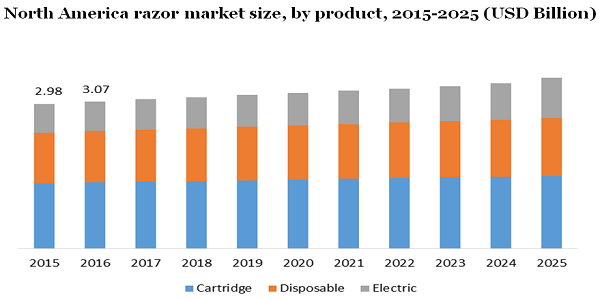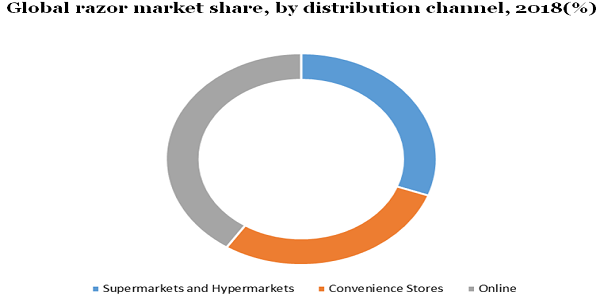- US: +1-408-610-2300
- Toll Free: +1-866-831-4085
- Become a Client
The global razor market size was accounted for USD 10.2 billion, in 2018 and is anticipated to grow at a CAGR of 3.5% over the forecast period, 2019 to 2025. The market growth is propelled by various factors like the growing focus of men on their grooming and increasing awareness of consumers regarding personal hygiene.
Disposable razors hold a significant share in the market and the demand for this category of razors would continue to grow owing to increasing usage in developing countries like India, Brazil, and Sri Lanka. Availability of domestic brands and the nominal price of the product are the major factors driving the product demand in these countries. However, electric shavers like trimmers and epilators are gaining traction due to their longevity and easy usage. The online channel is anticipated to mark positive growth in this segment because of hassle-free payment methods and a rise in digitalization through various channels.

Consumer consciousness regarding the environment is driving the producers to manufacture products using recyclable and environment-friendly materials and avoid making razors from heavy metals. However, sporting a beard has become extremely popular amongst millennials and this factor has been adversely impacting the market. Gillette reported that over the last decade the average number of times men shave every month has dropped down from 3.7 to 3.2. This reason has resulted in manufacturers coming up with numerous strategies like pitching attractive discounts to boost product sales.
By product, the market is divided into disposable, cartridge, and electric variants. The cartridge category ruled the market in 2018 with the largest share because of its easy application and reasonable price. Cartridge types are considered safe for all skin types and can be reused, thus, saving a lot on repetitive purchases. The cartridges are made up of steel or other alloy-based blades that make them rust-proof, thereby, driving the demand in the market. For example, Gillette Fusion ProGlide (with Flexball) is by far the most popular and widely used product in the cartridge razor market, as stated by company sources. The cartridge has five blades for easy rotations which ensure an incredibly close shave.
Electric shavers are anticipated to grow at the fastest CAGR of 4.3% over the forecast period. The major factor driving the product demand in this segment is the availability of international and local brands, starting from Braun and Philips to Indian brands like Nova and Syska. In countries such as, U.S., Germany, and U.K. where the personal care industry is prospering, the demand for such products is likely to grow, both in men or women.
While men dominated the razor market, in 2018, the women consumer category is anticipated to grow at the fastest CAGR of 3.9% over the forecast period. Growing consciousness among women regarding personal care and the strong impact of dynamic fashion trends are the major factors driving this consumer category. Consumer preference in dermatology and beauty clinics for various treatments is increasing owing to the wide usage of shaving razors as they offer a non-surgical and cheaper alternative. For example, Gillette Venus is a popular razor choice among Indian women for regular use since its inception.
The offline distribution channels like hypermarkets and supermarkets along with regular convenience stores have a larger share in the market globally when compared to online distribution channels. While hypermarkets and supermarkets held 30.6% of the share in 2018, convenience stores held 28.7% of the share in the same year. A wide range of products and brands are available via these offline distribution channels and they allow consumers to check the quality of the products. Further, offline stores allow consumers to compare the product with other substitutes present before taking a buying decision.

The online distribution channel is anticipated to grow at a CAGR of 3.9% over the forecast period. The emergence of various online stores like Nykaa, Amazon, and Purplle has contributed significantly to the growth of this segment. An increasing number of internet users, availability of a wide range of products, striking offers and discounts, and ease of access, are the prime factors driving product sales via online distribution channels.
North America ruled the razor market with a 32% share, in 2018 and is projected to grow steadily over the upcoming years due to the presence of key manufacturers like P&G and others. The availability of a wide range of technologically advanced products and increasing awareness of consumers regarding personal grooming are driving the product demand in this region. Increasing the use of electric trimmers across salons and homes in the U.S. for quick and effective results is one of the major factors attributing to the growth of the regional market.
The availability of skilled dermatologists and the growing popularity of hair removal solutions are some of the factors anticipated to drive the product demand in Europe. The presence of major market players and the introduction of new products is further driving the regional market. For example, Braun AG, a German Company, manufactures electric razors and epilators for women at diverse prices.
The Asia Pacific is anticipated to be the fastest developing regional market over the forecast period owing to increasing spending of consumers on personal care products including reasonable hair removal equipment. Increasing beauty consciousness in developing economies like China and India is projected to create growth opportunities. For example, Syska, an Indian lighting solutions company, manufactures a large number of hair trimmers at an affordable price range for consumers.
The major players in the industry include Koninklijke Philips N.V.; The Procter & Gamble Company; Harry’s Inc.; Supermax Limited; Societe BIC S.A. (BIC); Doroco Co. Ltd.; and Edgewell Disposable Company. Several leading brands have started offering subscription services to keep up with the ongoing trends in the industry. These services included promoting technologically advanced razors along with lower-end products. Some companies have also adopted go-to strategies like extending their product line to earn profit. For example, Harry’s started making products for feminine body hair care after serving men’s grooming products for a long time.
|
Attribute |
Details |
|
The base year for estimation |
2018 |
|
Actual estimates/Historical data |
2015 - 2017 |
|
Forecast period |
2019 - 2025 |
|
Market representation |
Revenue in USD Billion & CAGR from 2019 to 2025 |
|
Regional scope |
North America, Europe, Asia Pacific, Central & South America, Middle East & Africa |
|
Report coverage |
Revenue forecast, company share, competitive landscape, growth factors, and trends |
|
Country Scope |
U.S., Germany, U.K., China, India, Brazil, Saudi Arabia |
|
15% free customization scope (equivalent to 5 analyst working days) |
If you need specific information, which is not currently within the scope of the report, we will provide it to you as a part of the customization |
This report forecasts revenue growth at global, regional, and country levels and provides an analysis of the latest industry trends in each of the sub-segments from 2015 to 2025. For this study, Million Insights has segmented the global razor market report based on product type, consumers, distribution channel, and region:
• Product Type Outlook (Revenue, USD Billion, 2015 - 2025)
• Cartridge
• Disposable
• Electric
• Consumer Outlook (Revenue, USD Billion, 2015 - 2025)
• Men
• Women
• Distribution Channel Outlook (Revenue, USD Billion, 2015 - 2025)
• Supermarkets and Hypermarkets
• Convenience Stores
• Online
• Regional Outlook (Revenue, USD Billion, 2015 - 2025)
• North America
• U.S.
• Europe
• Germany
• U.K.
• the Asia Pacific
• India
• China
• Central & South America
• Brazil
• Middle East & Africa
• Saudi Arabia


Research Support Specialist, USA